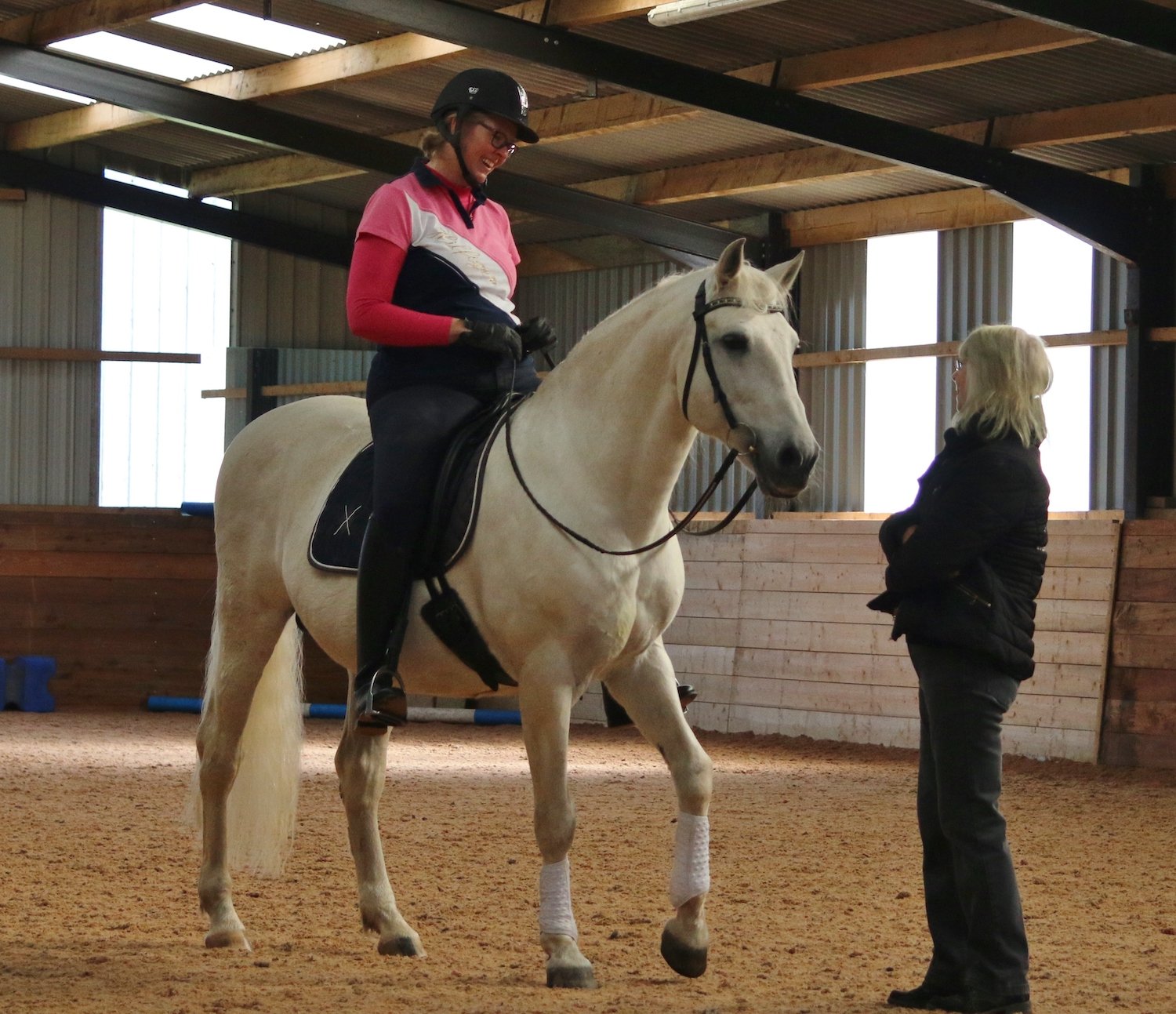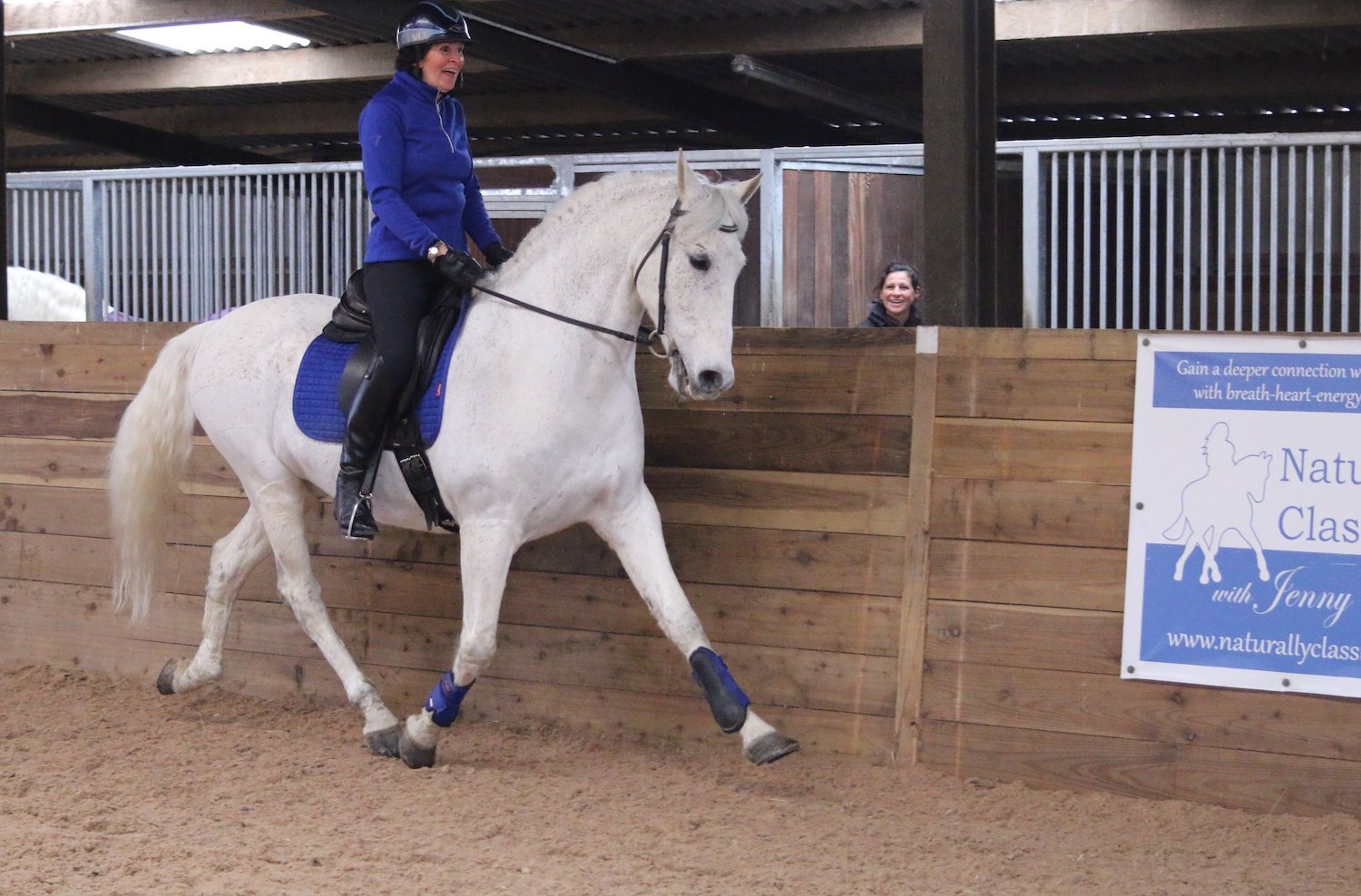Better connections
Watching Jenny work with her former bull-fighting stallion from the ground, it's clear to see they're both having a ball. Delfin dances around her, responding to her every movement, and changes in response to Jenny's energy levels.
"It started when I first brought Delfin home," she explains. "He wouldn't calmly stay out in a field on his own, because in his previous life he'd been kept in a stable 24/7. When I walked to the gate, he'd come galloping, so I'd stay with him."
But while carrying out chores within Delfin's sight line, Jenny began to notice something that she hadn't before. "When I moved, he moved. When I decided to incorporate loosework into his exercise programme, I realised that he was mirroring all my movements." Building this connection from the ground was vitally important in progressing Jenny's work with Delfin, but also lays the foundations of her teaching today.
Loosework is not just about sending your horse away – there should be communication.
A training tool
Jenny passes what she has learnt from working with Delfin on to her pupils. "When people come to me for ridden training with their horse, I always take the tack off and ask them to work loose with their horse first," says Jenny. "I think you should teach the rider separately, then add loosework with the horse before you even think about riding."
Your horse as teacher
Jenny says that Delfin has been her most inspirational teacher, and suggests you listen to your horse and how he is speaking to you. It's the perfect example of 'learn by doing'.
"Every horse is different and communicates in a slightly different way – just like people do," says Jenny. "It's important you listen and adjust as necessary. I still learn something every day from Delfin."
"I have used him to teach others how to feel a connection, too, and he's a great teacher. He won't connect if you are tense or preoccupied, and he doesn't like egos!."
"Once I was working with a woman whose husband had just walked out on her – something she hadn't mentioned to me before we started the session – and Delfin wouldn't connect. Once she'd told me about it, had a little cry and returned to the arena, Delfin would connect. Horses are so sensitive to our feelings and they don't like restrained behaviour."
Technique
The great thing about loosework is that you don't need lots of equipment to do it. All you need is you, your horse and an enclosed area – this doesn't have to be an arena, it could be your horse's field. Just remember to remove the other horses first or fence off an area.
Send your horse away by using an energising outward breath projected towards your horse, but make sure your energy is directed. "You are trying to herd the horse around you by directing your core energy to a place behind the shoulder on your horse," says Jenny. "Aim for where your leg would hang if you were riding. That is the part of the horse that's vulnerable – your horse can't see it, so if there was a predator there, they wouldn't be able to defend themselves."
Once he's moving, stand as if you were lungeing. "Try to get him to inscribe a circle around you," says Jenny. "You want to imagine there is a triangle and you are at the top. With the hand closest to the horse's head, you are going to guide him around you using a movement as if you were pulling a rope towards you.
Follow this up by bringing the whip around in your other hand pointed towards the rear of the horse. These are the three sides of the triangle – the horse, your hand nearest his head guiding him around and the line of the whip to his hindquarters."A deeper connection Now you have your horse moving and you're in position, it's time to build a better connection with your horse. It's not as simple as just sending him away, the communication should be fluid in both directions. After all, a lead mare would be unlikely to just continually chase. It's a means to an end – to create better relationships within the herd.
"When we look for a connection with core breathing, think of it as being like a wave," explains Jenny. "It's all energy, it's all life, it's all creation. It's like a wave on the sea, you are drawing in energy and empowering, then you are releasing directed energy. It's the same sort of energy flow when you are sitting on the back of the horse. It connects two living beings."
Using this energy flow, you can invite your horse to connect by lowering your energy levels. "I know that some people who practise natural horsemanship talk about waiting until the horse is licking and chewing before you invite them back in," says Jenny, "but the way I connect with my horses is not that structured. I lower my energy and ask my horse to connect when I feel like we are tuned in, just like a radio! You can tell if your horse is tuned in through his ears, expression and response to yourenergy levels.
"You should feel that if you use more of an energising outward breath, his energy rises and if you bring the breath in, he comes back to you – just like a wave in the sea."
Re-tuning
In an ideal world, your horse would respond to your core energy, breath and body language straightaway, but just because they understand what you are asking, doesn't automatically mean that they will respond. How many times have you sat on a wellschooled horse that ignored a gentle squeeze of the leg?
"On the ground, you are using core energy, power of intention and body language," says Jenny. "Then if your horse does not respond, give him a tap with the whip – just like you would to back up your leg aid when riding. If you keep using this sequence whenever you deal with your horse, he'll become very aware of your energy levels and your core energy. You are teaching him to listen."
Natural balance
It's important to get your horse listening because loosework can help your horse learn how to work in natural balance, but only if you can inject energy into his work. "If a horse doesn't move energetically, he tends to not be engaged," says Jenny. "He'll move around with his head up and his hindlegs out the back, rather than underneath him. If a horse isn't engaged mentally, he won't be engaged physically. "Ask your horse to move forward in his loosework by focusing your energy on him, and when he is energetic from behind and concentrating, he'll start moving through his spine and bring his hindlegs underneath. It's a great way to help your horse learn to balance and work well through his back."
HR tries it!
After a fabulous demonstration from Jenny and Delfin, it was my turn and I'm nervous, so Jenny asks me to do some exercises in the arena on my own to lower my energy levels and make me more centred. Then Delfin comes in.
"You are aiming for a steady rhythm, just as if you were riding," says Jenny after I'd accidentally used too much energy and sent Delfin flying down to the other end of the arena at gallop. "Remember the wave with the ebb and the flow. You are building a connection. Follow him around you in a circle with your body aimed at just behind his shoulder, and send the energy out with your outward breath and bring it in with your inward breath with the same rhythm that you want from the trot."
I try this, but it's still not working. Jenny explains: "Delfin is very high energy at the moment, so you need to lower yours. Move your core in the same rhythm as him. That's better."
After a couple of circuits in a rhythmical trot, it's time to ask him to connect with me. "Lower everything, lower your wrists and sigh deeply," says Jenny. "Look at him, he's not quite connecting with you so ask him to trot on again. Put on some more pressure and say, 'I'm here!'.
"When he is moving forward and you feel like you're tuned in, start to bring the energy into you. Lower your rhythm, become slow, draw your arms and hands into you. Relax your shoulders and he'll relax his, soften and lower your head. Don't hold any stress or tension."
On Jenny's advice, I visualise Delfin connecting. "Don't even think he won't connect! Draw him around in your mind. Don't move until he comes to you. Horses who are either high energy or agitated, like Delfin is here, will take longer to connect."
After several more tries, I manage to get close enough to connect with Delfin on some level, but not to the level that I would have liked. "He can feel your tension," explained Jenny. That must have been all the cameras on me!
The importance Of loosework
Working with your horse from the ground is beneficial in several ways.
It gives you the opportunity to see your horse's movement from the ground and it will give you a better idea of his athletic ability, so you can tailor his training. Start by asking a friend to walk your horse away from you and then back towards you. "Watch your horse's movement, starting at walk," says Jenny. "It is interesting to observe your horse from the ground – the swinging of the ribcage from left to right, any uphill movement, whether there is forward movement.When you are sitting on the back of the horse, you have to absorb all of this – any restriction in your body will stop it."
Working under saddle can bring problems, sometimes caused by rider position and at times caused by the horse's natural way of going.Watching your horse working loose can help you understand which it is for your horse.
You can see how your horse responds to your aids and energy, and then tweak how you are communicating to make your message clearer.
Loosework gives you the opportunity to judge whether you have enhanced or damaged your relationship with your horse during a ridden session. "When I've ridden, I'll take the tack off," explains Jenny, "and then see if my horse wants to connect. If he does, then I've kept my good relationship – I haven't been a bully!"
Every horse is different and communicates in a slightly different way – just like humans





